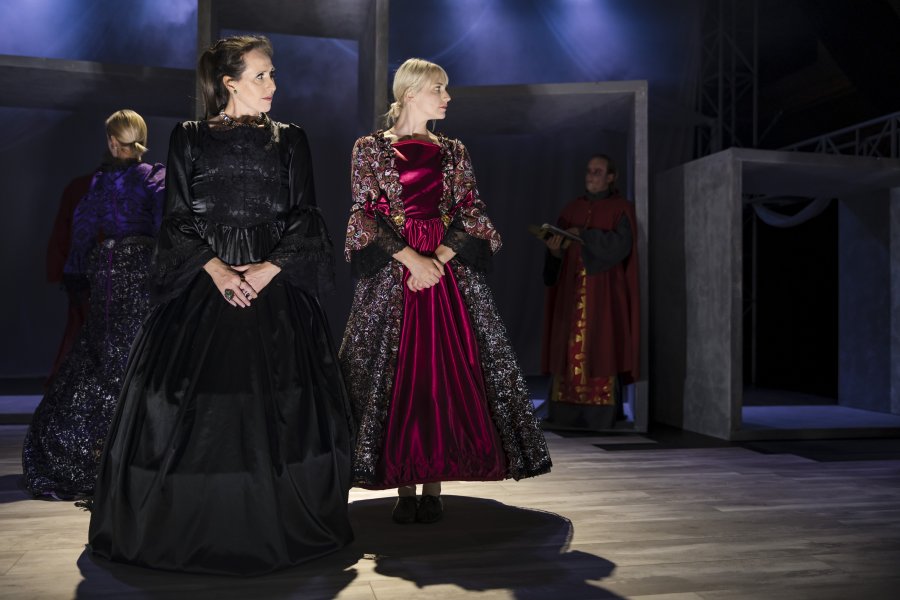By George Dixon
The Duchess of Malfi, written by John Webster in around 1612, is based on actual events in Italy. Giovanna d’Aragona was the real-life Duchess of Amalfi who was widowed at the age of 19, in 1498.
To bring the characters into context, Giovanna d’Aragona was born in 1478 to Enrico d’Aragona, the half-brother of King Frederick of Naples, making her a member of the Italian aristocracy.
She had two brothers: Luigi d’Aragona, a Cardinal of the Roman Catholic Church with power in the Vatican, and Carlo d’Aragona, Marquis of Gerace (Webster’s Ferdinand).
The Duchess of Malfi is a Jacobean tragedy characterised by corruption in the upper classes of society, horror, immorality, and a revenge tragedy.
It speaks today of corruption in high places, pride, greed, incestuous desires, secrets, murders, deceit, manipulation, and complete control of women.
The Duchess of Malfi is a widely studied play of significant importance.
This production of The Duchess of Malfi is adapted and directed by Tom Bradley, the director of Arrant Knaves Theatre Company, a Shakespearean theatre maker, whose expressed aim is to reimagine classical plays and texts to gain new insights into how these masterpieces reflect, uncomfortably, the fault lines that exist in contemporary society.
The Duchess of Malfi perfectly meets their brief.
It is pleasing to see the merging of seasoned and emerging talents on and off the stage.
Set Design Harry Gill is a recent graduate and the 2021 recipient of the Orloff Family. Charitable Trust Scholarship for excellence. Gill’s simplistic set of straight lines rather than archways enhances their use from scene to scene and is highly effective. The second level section brings the added aspect of the tower.
Lighting Designer Sidney Younger is also an emerging talent. Younger holds a Bachelor of Fine Arts Design and Production. The balance of silhouette lighting during some of the scenes is enough to convey the horrors of the expressed dialogue, expressing the action while not distracting from the character’s expressions.
The play runs for two hours plus a short interval.
The seamless changes between scenes are well-executed, and while the performance has a somewhat slow start, it becomes easier to become emerged in the play as it progresses.
The costumes are simple yet elegant. The Cardinal’s attire is a standout, as is the court gown Cariola wears.
Some stage props lack authenticity and because of this are a little off-putting and amateurish.
I found the makeup lacking on some of the central characters, with little transformation between being “sane” to “mad”. Unfortunately, the identity of the Mad Monk was not clear enough.
Most of the dialogue was clear, as it should be for this performance style.
Dialogue, words, tone, and rhythm are all hallmarks of a Shakespearian-style performance.
Unfortunately, though, I found it very hard to hear the words said by Delio, who stands as the moral centre of the play and, in effect, the recorder and teller of the tale.
Highlight performances from Bruce Langdon, The Cardinal, Christina Costigan, The Duchess, and Sophie Graham as Cariola. In their own ways, they managed to hold the audience’s attention.
Langdon’s lofty and slender physique projects an enduring image of a typical Cardinal. His mannerisms, expressions and stage direction enhance the character’s plausibility.
Costigan is amazing as the Duchess of Malfi; her poise and aura depict the strength of character, being a person of wealth and authority in a world ruled and controlled by men.
As a supporting character, Graham is a standout; her appearance commands the stage and the audience.
The relationship between Cariola and the Duchess is wonderfully directed, demonstrating their lifelong connection; at times, it only takes a look, and Cariola understands and knows what to do or what’s required, even though it’s scripted, the actions and expressions come over as natural.
Before attending, I was unsure if I would enjoy this production; within the first 5 minutes, I relaxed and started to enjoy it, and by the conclusion, I was completely satisfied, not just by the final scenes but by the journey.
Image: Daniel Rabin Photography





